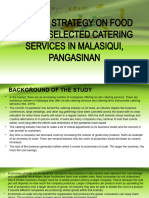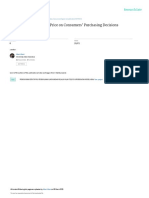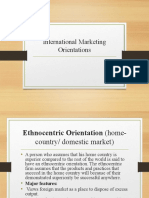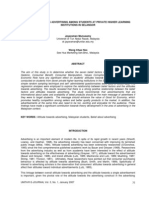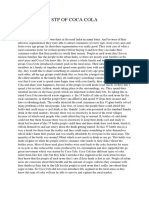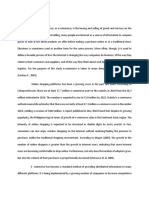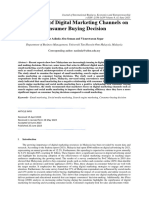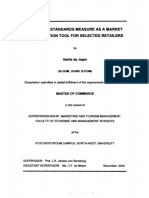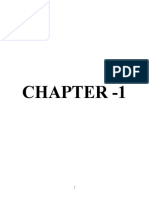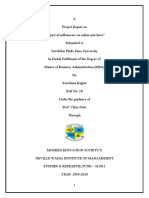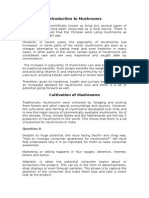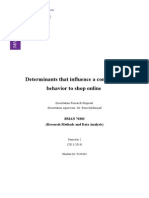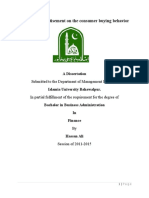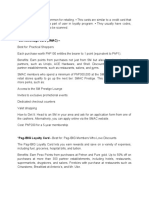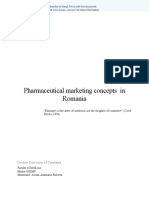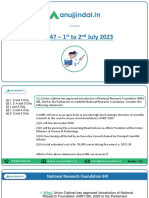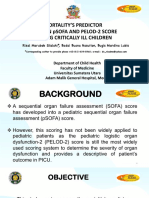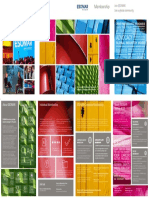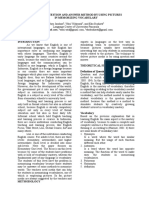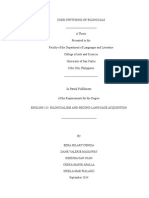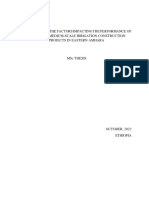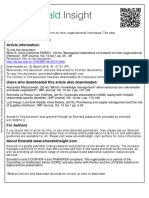Index
Content Page No
Acknowledgement 2
Business Profile and services 3
Consumer basic behavior 6
Using preference 9
Criteria 13
Motivational factor 18
Attitude 24
Learning 25
7P description 27
SWOT analysis 29
Analysis and Recommendation 30
Conclusion 31
Reference 32
Page | 1
� Acknowledgement
I would like to express my deepest appreciation to all those who provided me the
possibility to complete this report. A special gratitude I give to our course lecturer
Tahsina Tarannum, whose contribution in stimulating suggestions and
encouragement, helped us to coordinate our project especially in writing this
report.
Furthermore I would also like to acknowledge with much appreciation the crucial
role of the staff of MedCure Pharmacy, who has helped with all required
equipment and the necessary materials to complete this report. A special thanks
goes to my manager and Marketing promotion officer, who help us to assemble
the parts and gave suggestion about the report.
Page | 2
� Introduction
Pharmaceutical sectors of Bangladesh are one of the promising sectors of the
country (Sultana, 2016). Although the health sector is not fully developed because
of improper management of drugs, selling of adulterated and substandard drugs as
well as the lack of patients counseling ( Elias et al., 2016). Retail pharmacies are
the market place where the patients purchase medicines when they are required
and where they are wanted (Chagati, 2005). Retail pharmacies act as a bridge
among the patients, pharmaceutical manufacturers and physicians. In Bangladesh,
private or retail pharmacies are the most convenient ‘first point of call’ for advice
on common health related problems (Ahmed et al. 2009). Being a lower middle
income countries and shortage of physicians, the retailers of these pharmacies play
important roles in promoting access to medicines (Wafula et al. 2012).
The retail pharmacists should have qualification and license to sell pharmaceutical
preparation. Patient compliance is hindered in Bangladesh as these retailers are
mainly “C grade” pharmacists, who only take a short training of 12weeks and lack
of knowledge in patient counseling. The idea of model pharmacy has been
generated after this policy from Tanzania based “Accredited Drug Dispensing
Outlet” model which is also known as ADDO model. Before 2003, Duka La
Dawabaridi (DLDB) was the largest licensed outlets for essential medicines in
Tanzania. But after an assessment in 2001, it was found that, DLDB has certain
short comings like medicine quality, inadequate storage of medicines, untrained
staff, inadequate supervision and enforcement, authorization to sell only a limited
OTC medicines and illegal dispensing of prescription medicines. To solve these
problems, Management Sciences for Health’s Strategies for enhancing access to
medicines program began working with the government of Tanzania and ensure
the affordable, quality medicines and pharmaceutical services. According to the
DGDA the current number of model pharmacies in Bangladesh is 185.
Page | 3
� Business Profile & Our Service
The Old town areas of Dhaka have a large number of populations living among the
Dhaka city. There are over 650 pharmacies in old town among them over 60 is
situated in Lalbagh area.
We are glad to say that we have one of the biggest and major selling pharmacy in
Lalbagh area. “MedCure Pharmacy” was established in 2010, which is situated in
Water Works Road, Lalbagh, Dhaka. Our business is about to provide medicine in
retail price. We are licensed as a retailer business. We also provide OTC medicine,
Blood pressure measuring, Diabetics measuring, vaccine, Nebulizer, Injection,
Primary treatment on minor accident and stitching. We buy from supplier and sell
them to consumers in retail price. We have 6 employees and 2 cashier, who attend
our customer needs individually to give quality customer satisfaction.
Because of large number of population it becomes easy to run a business like this
and it is the major reason we have selected Lalbagh area for our business.
Our Slogan: Live healthy, Live happy, Live long
Our Mission: We aim to Provide Reliable, Effective. Efficient and Sustainable
Pharmaceutical and Medical Supply Chain Services for Health care Delivery.
Our Vision: To Attain Supply Chain Management excellence in Pharmaceuticals
and Medical Commodities.
Page | 4
� Consumer profile
The consumer is considered king in today's scenario of marketing. Now a days it
is consumer whose buying preferences decide what should be manufactured, in
what quantity and what should be the quality of the product.
Basically we deal with three types of consumer and two types of gender profile
Patient
Who receives medical treatment from doctor any
buys medicine by doctors prescription
OTC consumer
Who buys medicine without prescription or by basic
diagnosis
Regular consumer
Who buys medicine daliy, weekly or montly basis
Male Female
12%
88%
Page | 5
� Consumer Basic Behavior
Consumer behavior is the study of individuals, groups, or organizations and all the
activities associated with the purchase, use and disposal of goods and services,
including the consumer's emotional, mental and behavioral responses that precede
or follow these activities.
The Organizational Consumer
The Personal Consumer some institutions ans school buys
Some consumers byues medicine medicine from us
for his or her own use like- Little Birds School, Kisholoy
Uccho Balika Bidddaloy
The Ultimate ConsumerSome The Individula buyes
consumres buys medicine for
other members for his or her Some counsumer buyes medicine for
family members temporary use
Page | 6
� Market Segmentation
Market segmentation is the process of dividing a market of potential customers
into groups, or segments, based on different characteristics
There are three types of segmentation
Page | 7
�Base of segmentation there are 9 factors
• Region- Bangladeshi
Geographic Sementation • State- Dhaka
• City- Dhaka
Demographic Segmentation • Sex- Male. Female
• Merital status- Married, Unmarried
Psychological Segmentation • Motivation
• Attitute
• Lifestlye
Psychographic Segmantation
• Presonality
• Merital status
Socio-cultural Segmentation
• Family life cycle
• Loyalty
User-related Segmentation
• awarness
• Rate of usages
User-situation Segmentation
• Heavy vs light
• Rewards
Benifits Segemntation
• benifits
• Variables
Hybrid Segmentation
• cummunity
Page | 8
� Consumer preference
The consumer is considered king in today's scenario of marketing. Now a days it
is consumer whose buying preferences decide what should be manufactured, in
what quantity and what should be the quality of the product.
Consumer preference is defined as the subjective tastes of individual consumers,
measured by their satisfaction with those items after they've purchased them. This
satisfaction is often referred to as utility. Consumer value can be determined by
how consumer utility compares between different items.
A majority (68%) of the clients visiting the drug shops came by self-referral and
without a prescription. Dispensing drugs on the basis of a patient’s request (83%)
or a patient’ssymptoms of illness (59%) was quite common. Other than selling
medicines, the drug shops provided additional services such as pushing injections
(60%), basic diagnostic services (63%), burn and wound dressings (63%), and
vaccinations (31%), all of which are not sanctioned by the drug license.
Self referal or without prescription (OTC)
Recurring medicine
Patients symtoms of illness
basic dignosis
vaccination
burn
dreassing
Page | 9
�Most frequently purchased OCT
Pain Relief 47.5
Allergy 21.6
Cough / Cold 18.6
Heartburn 10.8
Other 1.5
OTC Medicine
50
47.5
45
40
35
30
25
Series 1
20 21.6
18.6
15
10 10.8
5
0 1.5
Pain Relief Allergy Cough / Cold Heartburn Other
Page | 10
�Medicine purchased by Doctors reference
Antibiotic 46%
Allergy 54.9%
Asthma 3.4%
Antacid 42.2%
Anti-Itch cream 24.5%
Anti-diarrhea 18.6%
Athlete’s foot products 10.3%
Cold 65.2%
Constipation relief 19.6%
Cough 55.9%
Diaper cream 4.4%
Energy / alertness aids 5.4%
Eye drops 37.3%
First aid cream 27.9%
Flu 23.5%
Gas relief 15.7%
Heartburn relief 39.2%
Lactose intolerance 2.0%
Motion sickness / anti-nausea 4.9%
Mouth rinses 42.2%
Nasal / saline spray 20.6%
Nicotine gum/patches 3.4%
Pain reliever or fever reducer 71.1%
Probiotics 10.8%
Sinus medicine 28.9%
Sleep aids / sleep medicine 20.6%
Toothpaste 71.1%
Other 1.5%
Page | 11
�Medicine is the cure which is used to take in simple to major diseases from a little
baby to aged people so we are used to deal with all the age group from lower class
to upper class.
But as a business men our vision is different. We divide our customer by mostly 3
types
Customers of the largest number (49%; ‘convenience customers’) are
mostly younger consumers. They gave moderate to positive ratings to
factors affecting the selection of pharmacy and OTCs; convenience, and
previous experience and the pharmacist’s opinion, received the highest
ratings.
(OTC) medicines means Over-the-counter, the drugs consumers can buy
without a prescription. Some OTC medicines like relieve aches, pains, and
itches.
Customers of the second cluster (35%; ‘loyal customers’) are mainly
retired; most of them reported visiting a single pharmacy. They gave high
ratings to all factors that influence pharmacy selection, especially the
pharmacy’s staff, and factors influencing the purchase of OTCs,
particularly previous experience and the pharmacist’s opinion.
Customers of the smallest cluster (16%; ‘convenience and price-sensitive
customers’) are mainly retired or unemployed with low to moderate
education, and low personal income. They gave the lowest ratings to most
of the examined factors; convenience among factors influencing pharmacy
selection, whereas previous experience, the pharmacist’s opinion and
product price among those affecting the purchase of OTCs, received the
highest ratings.
Page | 12
� Criteria of our consumers
Gender
Male 88%
Female 12%
Gender Group
Female
12%
Male
88%
Page | 13
�Age
18-29 19.3%
30-39 42.5%
40-49 28.4%
50-69 6.8%
70 or older 3.3%
70 or older Age Group
3%
50-69 18-29
7% 19%
40-49
28%
30-39
43%
Page | 14
�Education
Less than High School 12%
Completed High School 23%
Some College/Technical School 32%
Graduated College/Technical School 26%
Graduate Degree/PhD or more 7%
Graduate Education
Degree/PhD or Less than High
more School
7% 12%
Graduated
College/Technic
al School Completed
26% High School
23%
Some
College/Technic
al School
32%
Page | 15
�Occupation
Job 28%
Business Man 38%
Housewife 6%
Student 4%
Unemployed 3%
Others 11%
Occupation
Unemployed
Others
3%
12%
Student Job
5% 31%
Housewife
7%
Business Man
42%
Page | 16
�Income
0 to 14,999 8%
15,000 to 24,999 10%
25,000 to 34,999 28%
35,000 to 44,999 22%
45,000 to 64,999 16%
65,000 to 74,999 10%
75,000 or more 8%
Income
75,000 or more
8%
0 to 15,000 to
65,000 to 24,999
74,999 14,999
8% 10%
10%
45,000 to
64,999 25,000 to
16% 34,999
27%
35,000 to
44,999
21%
Page | 17
� Motivational Factors of our consumer
For common G.I. disorders (Flatulence/ Acidity/ Constipation/ Ulcer etc.), 35%
data found to follow physician’s prescription, 19% take medicines on pharmacist’s
suggestion, 10% prefer home remedies, 12% people follow family/friend’s
advice, 5% follow instructions of advertisement/literature/internet while 19%
were self directed to choose their medicines. Similarly, for fever & common pain
related problems 14% physician’s prescription, 18% take medicines on
pharmacist’s suggestion, 13% prefer home remedies, 11% people follow
family/friend’s advice, 5% follow instructions of advertisement /literature/internet
while39% were self directed to choose their medicines.
For skin/hair related problems 44% data found to follow physician’s prescription,
11% take medicines on pharmacist’s suggestion, 13% prefer home remedies,
12% people follow family/friend’s advice, 5% follow instructions of
advertisement /literature/internet while15% were self directed to choose their
medicines.
For skin/hair related problems 44% data found to follow physician’s prescription,
11% take medicines on pharmacist’s suggestion, 13% prefer home remedies, 12%
people follow family/friend’s advice, 5% follow instructions of advertisement
/literature/internet while15% were self directed to choose their medicines. For
Dental problems 45% data found to follow physician’s prescription, 15% take
medicines on pharmacist’s suggestion, 14% prefer home remedies, 08% people
follow family/friend’s advice, 3% follow instructions of advertisement
/literature/internet while15% were self directed to choose their medicines; and for
common wounds/ cuts or injuries 24% data found to follow physician’s
prescription, 17% take medicines on pharmacist’s suggestion, 16% prefer home
remedies, 5% people follow family/friend’s advice, 3% follow instructions of
advertisement /literature/internet while 35% were self directed to choose their
medicines.
Page | 18
� 5%
5% 10%
physician
8% pharmacist
family /friend's advice
60%
12% magazine/ literature
internet
self
Consumer perception
A marketing concept that encompasses a customer's impression, awareness and/or
consciousness about a company or its offerings. Customer perception is typically
affected by advertising, reviews, public relations, social media, personal
experiences and other channels.
Exposure Attention Interpretati Memory
Page | 19
�Customer perception about our pharmacy:
Customer perception affects not only those consumers who purchase your products
or services, but also anyone who sees your product or service without engaging in
a transaction.
Our customers is our main priority, we attain their perception by:
Our store is quite big and situated in front of main street of lalbagh so it’s
easy for customer to find our store. We hung a big billboard in the upper
side of store, there have also two small billboard in both sides of the store
which draw attention of customers.
For advertisement, we use Tv ads, banners and poster. We fixed banners
and posters in around 1 kilometer of area.
We have 6 employees and 2 cashier, who attend our customer needs
individually to give quality customer satisfaction.
We provide quality product in a satisfied rate to our customers.
Dishonesty, rough behave, greediness and soulless is sickly monitored
during customer interaction. We provide well manner, strong values, a clear
direction, and a positive brand image to our customers to maintain good
relationship.
Buying a branded product isn’t just about getting hold of something a
customer need. We suggest them what is really good for them.
Page | 20
�Elements of perception
Sensation:
Sensation is the immediate and direct response of the sensory organs to stimuli.
For our consumer their sensation is our medicine, medicine packaging, brand
name, our advertisement etc
Absolute threshold:
The lowest level at which an individual can experience a sensation is called
sensation
For our consumers their absolute threshold is to notice us or our shop. That’s why
we fixed a big bill board in front of our store so that consumers can easily track us.
Different threshold
If the low price medicine increase their price 1 tk in a box but if the increase 10tk
each box, consumers will hesitate before buying.
Subliminal perception
Suppose, gas relief capsule like Omeprazole and Renitid are the same. But if a
consumer know less about it, after knowing that we have Renitid instead of
Omeprazole, they wont’t buy that because they don’t know they are the same but
from different groups.
Page | 21
� Consumer personality
Based on this, consumers are classified into three personality types −
Complaint Personalities –
They prefer love and affection and so they move towards them and so they prefer
known brands.
Aggressive Personalities –
They tend to move against others and they show off their need for power, success
etc which is quite manipulative.
Detached Personalities –
They are not much aware of brands and are more self reliant and independent.
According to traits theory
Consumer Innovativeness - measures how open and receptive a consumer is
towards a new product or service/ brand OR even to changes made to any or all
of the 4 Ps.
Dogmatism - measures the extent of rigidity within a consumer towards
something that is new, or unfamiliar or contrary to established preconceptions,
ideas and beliefs.
Social Character: - reflects the degree to which a consumer relies on self or on
others in making purchase decisions and forming consumption pattern
Optimum Stimulation Levels (OSL) - measures the degree of calm or excitement
that a person desires. - each one of us has an OSL limit. - some of us desire a
Page | 22
�calm, simple and uncomplicated or uncluttered life; others seek a life that is busy,
complex, novel and full of excitement.
Variety Novelty Seeking - measure the level of variety that a person seeks while
purchase of products and services/brands.
Sensation seeking- A personality trait characterized by the need for varied, novel,
and complex sensations, experiences and willingness to take physical and social
risks for the sake of such experience
• Pharmacuticals has recently launched
"Fiberlax" syrup for gas relife insted of
Consumer Innovativeness capsule
• Open minded: Consumers buys same
medicine bt oher group or company
Dogmatism • Close minded: Consumees wants to
buy same group or company medicine
Social Character • Buys brander medicine
Optimum Stimulation Levels • Buyes the same medicine always
Sensation seeking • Buyes the same medicine always
Page | 23
� Customers Attitude
Consumer attitude may be defined as a feeling of favorableness or unfavorableness
that an individual has towards an object. As we, all know that an individual with a
positive attitude is more likely to buy a product and this results in the possibility of
liking or disliking a product.
Tricomponent attitude model
Cognitive component:
Cognitive means the knowledge and perception that are acquired by a combination
with the attitude object and related information from various sources.
Many of our consumers knows about medicine like we does. They refers
themselves that which medicine will be better form them
Page | 24
�Affective component
A consumers emotions or feelings about a particular product or brand constitute
the affective component of an antitude.
Many of our consumer uses only reputed branded medicine like- Squre
pharmaceuticals, Beximco pharmaceuticals or Incepta pharmaceuticals
Conative component:
The conative component is frequently treated as an expression of the consumers
intention to buy.
Consumer Learning
According to Kotler’s Definition, learning involves changes in an individual’s
behavior arising out of the experience. Most of the human behavior is learned over
time, out of the experience.
Elements of Consumer Learning
Motivation
Motivation is the driving force of all important things to be learnt. Motives allow
individuals to increase their readiness to respond to learning. It also helps in
activating the energy to do so. Thus the degree of involvement usually determines
the motivation to search information about a product.
For going to a pharmacy or buying medicine, it has a reason, which is sickness. A
consumer know that without sickness there is no need to medicine.
Page | 25
�Cues
Motives encourage learning and cues stimulate the direction to these motives. Cues
are not strong as motives, but their influence in which the consumer responds to
these motives.
Most of the consumers want discount for their purchase. Wants good packaging or
design. We have these kind of facilities
Response
Response signifies how a consumer reacts to the motives or even cues. The
response can be shown or hidden, but in either of the cases learning takes place.
Often marketers may not succeed in stimulating a purchase but the learning takes
place over a period of time and then they may succeed in forming a particular
image of the brand or product in the consumer’s mind.
If we don’t inform our consumers that we give 12% discount in their purchase,
they won’t be aware. So we have hang a poster in front of our store door so thay
can easily be motivated to buy from us.
Reinforcement
Reinforcement is very important as it increases the probability of a particular
response in the future driven by motives and cues.
If a consumer didn’t get what he wants, or gets rough behave form us, or sees
defect on our medicine they won’t buy from us.
Page | 26
� 7P’s of our pharmacy policy
Place:
We are the retail seller of drugs. Our store is quite big and situated in front of main
street of lalbagh so it’s easy for customer to find our store. It is one of the over
populated area in Old town of Dhaka. So it make our business more profitable.
Price:
We provide quality product in a satisfied rate to our customers. We also give 12%
discount in medicine purchase. It make our store more highlight then others.
Page | 27
�Product:
All the branded medicine and equipments are available in our pharmacy. We
maintain well finished packaging to our consumers.
Promotion:
We hung a big billboard in the upper side of store, there have also two small
billboard in both sides of the store which draw attention of customers. • For
advertisement, we use Tv ads, banners and poster. We fixed banners and posters in
around 1 kilometer of area.
People:
We have 6 employees and 2 cashier, who attend our customer needs individually
to give quality customer satisfaction.
Process:
After consumers enters in our pharmacy, at first we give greetings to our
customers, then we hear about their problem and give safe solution and medicine
for it.
Physical evidence:
We always talks with our consumers smartly. Never misbehave with them. We
provide them discount and bags for purchasing medicines.
Page | 28
�SWOT analysis
Page | 29
� Analysis and Recommendation
Medicine is the cure which is used to take in simple to major diseases from a little
baby to aged people so we are used to deal with all the age group from lower class
to upper class.
But as a business men our vision is different. We divide our customer by mostly 3
types
Customers of the largest number (49%; ‘convenience customers’) are
mostly younger consumers. They gave moderate to positive ratings to
factors affecting the selection of pharmacy and OTCs; convenience, and
previous experience and the pharmacist’s opinion, received the highest
ratings.
(OTC) medicines means Over-the-counter, the drugs consumers can buy
without a prescription. Some OTC medicines like relieve aches, pains, and
itches.
Customers of the second cluster (35%; ‘loyal customers’) are mainly
retired; most of them reported visiting a single pharmacy. They gave high
ratings to all factors that influence pharmacy selection, especially the
pharmacy’s staff, and factors influencing the purchase of OTCs,
particularly previous experience and the pharmacist’s opinion.
Customers of the smallest cluster (16%; ‘convenience and price-sensitive
customers’) are mainly retired or unemployed with low to moderate
education, and low personal income. They gave the lowest ratings to most
of the examined factors; convenience among factors influencing pharmacy
selection, whereas previous experience, the pharmacist’s opinion and
product price among those affecting the purchase of OTCs, received the
highest ratings.
Page | 30
� Conclusion
The behavior of pharmacy consumers has here been researched to discover the
factors behind their behavior for prescription and non-prescription drugs. The
decision making and factors affecting choice of pharmacy and choice of generic
and similarly priced medicines have also been studied. Consumers of different age
groups, gender and occupations were included in the research.9 The research was
almost entirely conducted amongst the peoples in society as well as patients from
hospitals. The data found quite interesting as most of the people are found
escaping to spend money for proper medication. Although people were earning
handsome amount as their monthly income; but on the choice of medicines (either
prescription or non-prescription) they were found very choosy. People prefer self
medication beyond the expectations, likewise they do follow family and friend’s
advice, meanwhile internet/advertisements and literature etc. were also their
preferred choice to make decision for purchasing drugs. Even in common ailments
data were found as, people bypass the physician’s prescription and 20% people go
for most branded medicines. Similarly Pharmacist’s advice is of no matter, even
about 15-20% people go for home remedies.
Page | 31
� Reference
Lecture sheet
www.google.com
https://www.ConsumerNavigationandSelectionBehaviorsforOTCProductsinaRetail
Setting
https://www.researchgate.net/publication/307571705_Study_of_Consumer's_Phar
maceutical_Buying_Behavior_Towards_Prescription_and_Non-
Prescription_Drugs
Kamat, V.R., and M. Nichter. 1998. “Pharmacies, self-medication, and
pharmaceutical marketing in Bombay, India.” Social Science and Medicine 47 (6):
779–94.
Page | 32


